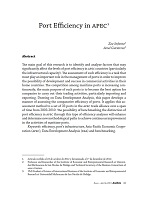Port Efficiency in APEC
DOI:
https://doi.org/10.32870/mycp.v2i3.397Keywords:
Efficiency, port’s infrastructure, Asia-Pacific Economic Cooperation (apec), Data Envelopment Analysis (dea) and benchmarking.Abstract
The main goal of this research is to identify and analyze factors that may significantly affect the levels of port efficiency in apec countries (particularly the infrastructural capacity). The assessment of such efficiency is a task that must play an important role in the management of ports in order to improve the possibility of development and success in commercial activities in their home countries. The competition among maritime ports is increasing continuously; the main purpose of such ports is to become the best option for companies to carry out their trading activities, particularly importing and exporting. Drawing on Data Envelopment Analysis, this paper develops a manner of assessing the comparative efficiency of ports. It applies this assessment method to a set of 33 ports in the apec trade alliance over a span of time from 2003-2010. The possibility of benchmarking the distinction of port efficiency in apec through this type of efficiency analyses will enhance and determine new methodological paths to achieve continuous improvement in the activities of maritime ports.Downloads
References
Ali, A.I. (1994). Computational Aspects of dea In Data Envelopment Analysis. Theory, Methodology and Applications, Boston: Kluwer Academic Publishers.
APEC Secretariat (2012). Asia-Pacific Economic Cooperation. Consulted 2012- 10-01. www.apec.org.
Arzubi, A., & Berbel, J. (2002). ‘Determinación de Índices de Eficiencia Mediante DEA en Explotaciones Lecheras de Buenos Aires’.
Investigaciones Agrarias, 17(1): 103-123. Banker, R. D., Charnes, A., &
Cooper, W. W. (1984). ‘Some Models for Estimating Technical and Scale Inefficiencies in Data Envelopment Analysis’. Management Science, 30(9): 1078-1093.
Bemowski, K. (1991). The Benchmarking Bandwagon. Quality Progress. Bosch, E.
A., Navarro, A. I., & Giovagnoli, P. I. (1999). ‘Eficiencia Técnica y Asignativa en la Distribución de Energía Eléctrica: El Caso de epe sf’. Asociación Argentina de Economía Política, 1-24.
Chang, S. (1978). ‘Production Function, Productiveness and Capacity Utilisation of the Port Mobile’. Maritime Policy and Management , 5(4): 297-305.
Charnes, A., Cooper, W. W., & Rhodes, E. (1962). ‘Programming with Linear Fractional Functionals’, Naval Research Logistics Quarterly, 9(3): 181-185.
Cooper, W. W., Seiford, L. M., & Tone, K. (2000). Data Envelopment Analysis: A Comprenhensive Text with Models, Applications, References and deaSolver Software. Boston: Kluwer Academic Publishers.
Cooper, W. W., Seiford, L. M., & Zhu, J. (2004). Data Envelopment Analysis: History, Models and Interpretations. Boston: Kluwer Academic Publishers.
Cullinane, K., & Song, D. W. (2003). ‘A Stochastic Frontier Model of the Productive Efficiency of Korean Container Terminals’ . Applied Economics , 35(3): 251-267.

Downloads
Published
How to Cite
Issue
Section
License
Open Access Policy
This journal provides open access to all its contents, in adherence to the principle that making research freely available supports a greater global exchange of knowledge.
MyCP is licensed under a Creative Commons Attribution-NonCommercial license, also known as CC BY-NC.
Contents are published in both PDF and XML formats.
Authors who publish in México y la Cuenca del Pacífico must accept the following conditions:
Pursuant to Mexican copyright laws, México y la Cuenca del Pacífico acknowledges and respects the authors’ moral right and ownership of property rights, which will be assigned to the University of Guadalajara to publish the articles in an open-access mode.
México y la Cuenca del Pacífico does not charge the authors any fees for receiving and processing their articles.
Authors are permitted to enter into other independent and additional contractual agreements for the non-exclusive distribution of the article version published in México y la Cuenca del Pacífico (for example, publishing it in an institutional repository or in other printed or electronic media) as long as they clearly state that the piece was originally published in México y la Cuenca del Pacífico.
Pursuant to the above, once the article is approved for publication, authors must send the Assignment of Rights Agreement form duly filled and signed. This form must be sent to mexicoylacuenca@gmail.com as a PDF file.
Readers/users of México y la Cuenca del Pacífico can freely access the journal new issues as soon as they are uploaded. Readers/users are allowed to cite, share (both electronically and physically), print and distribute the material, provided they expressly state that the work was originally published in México y la Cuenca del Pacífico. Contents are to be properly cited and never for commercial purposes.




